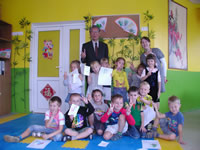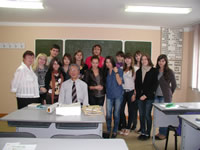What's Happening with Haiku in the World Now
The Introduction of Haiku in Vladivostok
Hidenori Hiruta
This autumn, thanks to the project of the Akita International Haiku Network led by Chief Director Minoru Kono, I had an opportunity to introduce haiku mainly to the students of Far Eastern Federal University Institute of Oriental Studies in Vladivostok.
I left Akita on September 25, 2011 and arrived at Vladivostok that evening, staying till October 2.
During my stay there, Mr. Sohei Oishi, Director of JAPAN CENTER IN VLADIVOSTOK as well as Ms. Aida Suleymenova, the associate professor of Far Eastern Federal University (Chairperson of ‘Yosano Akiko Memorial Literary Society’) kindly gave their cooperation, helping me introduce and spread haiku through school visits, workshops, and a talk.
Mr. Ilya Dyakov, a FEFU student, helped me with my activities as an interpreter and guide.
On the afternoon of September 26, I paid a courtesy visit to JAPAN CENTER and the Chair of Japanese Philology of Far Eastern Federal University Institute of Oriental Studies.
When I met Director, Sohei Oishi and Head of the Chair, Alexander Shnyrko, I delivered to them the message from the HIA president, Dr. Akito Arima, and presented them with HI No.94 and No.95. I told them about the aims of my visit, and asked them for their cooperation, hoping for a further spread of haiku in Vladivostok.

On my courtesy call, to my great surprise, I found the image of Buddha and the monument of YOSANO Akiko and her poems Starting on a Journey, erected in the front garden of the FEFU Institute of Oriental Studies. There is also the monument of the Urajio Honganji Temple near the FEFU buildings.
While staying in Vladivostok, I enjoyed talking about haiku to those children, students, and people who are interested in the Japanese language and Japanese culture.
In my visits to Eastern School, I talked about haiku with the teachers of Japanese and presented them with three books ‘Haiku by World Children (Chikyu Saijiki)’ of Vol.8 (Impressions of Water),Vol.10 (Impressions of Wind), and Vol.11 (Impressions of School) published by the JAL Foundation, and also with the posters of the ‘World Haiku Children’s Contest’ made by the JAL Foundation.
After that, I told about haiku to kindergarten children studying Japanese in two classes for 20 minutes. I taught the word ‘Haiku’ to them, and presented them with the haiku by a six-year old Russian child from ‘Chikyu Saijiki’.
The snails are little bit late
To the school
For twenty-four hours.
Laughter spread in the classroom with the translation by a FEFU student.
I also taught the words ‘rock-paper-scissors’ in Japanese, and the winner could choose any favorite one out of the haiga postcards made by Akita International University students from overseas through this ‘rock-paper-scissors’.
In a class for elementary pupils (from the age of 7 to 9), who study Japanese as their selective subject, I enjoyed the haiku lesson for 60 minutes. I presented several haiku and pictures by Russian children from ‘Chikyu Saijiki’.
The pupils enjoyed reading each haiku in chorus in Japanese as well as in Russian.
I also presented them with the haiga copies painted by an elementary pupil in Akita prefecture as well as the haiga postcards by AIU students from overseas.
Lastly, the pupils enjoyed drawing a picture or writing haiku for ‘World Children’s Haiku Contest’ by the JAL Foundation, whose topic is ‘Festivals’.
I gave the four-day workshops of 90 minutes on writing haiku, short poems, at the FEFU School of Regional and International Studies.
After the workshops the teachers gave me their comment, saying that they will take up haiku in classes from now on.
My teaching procedure was as follows.
- About haiku composed in Japanese.
- About haiku composed in English.
- About haiga and haiku.
- Appreciation of haiga and haiku written in Japanese by a junior high school girl student in Akita prefecture.
Reciting her haiku in Japanese and translating her haiku into Russian. - Appreciation of haiga postcards by Akita International University students from overseas.
Reciting their haiku in Japanese and translating their haiku into Russian. - Composing haiku in Japanese as well as in Russian.
- Presentation of haiku by the students.

The students gave a presentation of their haiku composed in Japanese and Russian, which was very highly motivated and fluent.
I found that the students prefer those haiku which are humorous or ironical. They like haiku, whose implication has something light, far from serious. The following haiku by Basho pleased them most, causing laughter.
鶯や餅に糞する縁の先 芭蕉
Uguisu ya mochi ni fun suru en no saki
Bush warbler ―
Shits on the rice cakes
On the porch rail
Basho
Translated by Robert Hass
In Japan Center in Vladivostok I gave a talk on ‘Haiku and Tea Ceremony’ to the members of the tea club ‘Ichigo Ichie no Kai’ formed for the cultural course.
Before the talk they served me a bowl of green tea made through the tea ceremony style.
In return I presented them with my two favorite Japanese traditional folk songs, ‘Kuroda Bushi(黒田節)’ in Fukuoka prefecture and ‘Obonai Bushi(生保内節)’ in Akita prefecture.
Then I recited my haiku I had written in the Shinkansen for Tokyo on September 25, in which I borrowed the words ‘treasure-like wind’ used in the folk song ‘The Obonai Bushi’.
宝風立つ高原や蕎麦の花 秀法
takara kaze tatsu kougenn ya soba no hana
treasure-like wind
favors the height ―
buckwheat flowers
Hidenori
After that, I started talking about ‘Haiku and Tea Ceremony’.
First of all, I presented the audience with several haiku by Basho.
The first haiku was the one written in Kisakata, Akita prefecture, and the others were my favorite haiku of Basho’s.
The last haiku was this one.
古池や蛙飛びこむ水の音 芭蕉
furuike ya kawazu tobikomu mizu no oto
The old pond;
A frog jumps in –
The sound of the water.
Basho
Translated by R. H. Blyth.
I took up 'the sound of water'in Basho's haiku, comparing that sound with 'the sound made in mixing the powdered green tea with the hot water by a bamboo tea whisk' in the tea bowl at tea ceremony.
I told that Zen has had a deep influence on both haiku and tea ceremony.
I concluded that haiku seeks for "pure present", the eternal now, and tea ceremony seeks for "pure present", the now as it should be, in each little space.
After the talk they gave me the comment, saying that they will take up 'Haiku and the Season Words' as the topic in the following cultural course.
This is because my talk caused a great sensation among the audience, I hear.
As a special guest Ms. Larissa Semyonova, a haiku poet, living about 750 kilometers away from Vladivostok arrived at Japan Center by bus and train.
Ms. Semyonova, whose pen name is 'Isa', is a Facebook friend of mine, who lives in Primorsky Krai, teaching haiku to children at the circle on Japan she formed as a volunteer for an elementary school.
"побились тарелки" - пара строк
от токийского друга...
густой мартовский снег
(Иса)
降りしきる雪の三月
届く声「食器割れた」と
東京の友
(イサ)
I hope that such cultural exchanges as this will increase, making haiku poets come and go by the Trans-Siberian Railway, and that haiku will spread throughout Russia, and haiku will be loved more and more by Russian people.
(Hidenori Hiruta, Editor of Akita International Haiku Network, Editor of “Akita-the Land of Poetry”. Member of HIA )
